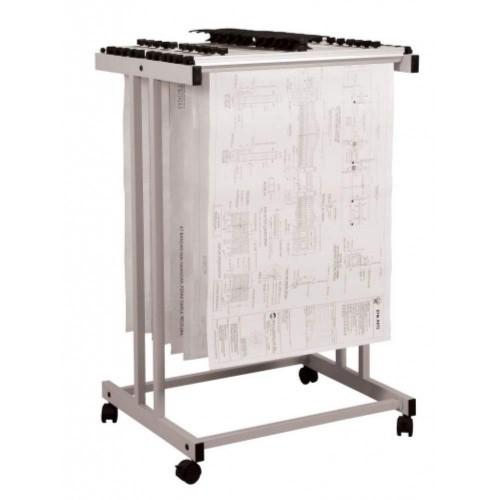
Anyone involved in engineering, technical planning, or architecture can benefit from a good-quality drawing plan hanger system.
The systems are a smart addition to the office, as they allow you to store, access, and display your drawings easily and quickly without fear of creasing, staining, or other damage.
There are several different types of plan hangers, so we compiled this quick guide to explain what they are, why you should use them, which ones are best and their alternatives.
What is a Drawing Plan Hanger?
A drawing plan hanger typically consists of a horizontal bar that holds a sheet of paper. The hangers can be found in a variety of sizes to suit whatever size paper you typically work with, from A0 through to A3.
They are connected to a holder fixed to a wall or a freestanding frame/trolley. It allows for space-saving storage of vast quantities of drawings and plans and makes it very easy to find specific pages, display pages in position, and share ideas.
Why Should You Use a Drawing Plan Hanger?
The alternative to a drawing plan hanger is to use a drawer unit or cabinet because they store the paper horizontally. However, these alternatives can take up more floor space than a hanger as they store sheets, one on top of the other.

Image credit: pinterest.co.uk
This disadvantage makes it difficult and time-consuming to find the exact drawing or plan you are looking for.
Also, drawer storage is more likely to result in furling, creasing, and other forms of damage. Drawing plan hangers are a very cheap alternative to cabinets and are perfect if you frequently need to reference your work or display it to colleagues or clients.
But they present some drawbacks due to the way the sheets are stored and exposed to the elements. So, for long-term storage or archiving, you might want to move your drawings into a cabinet.
Additionally, there is no security with a hanger.
Drawing plan hangers can be accessed quickly and easily by anyone in your office. So, if you’re working on confidential plans or need to keep your work private for any reason, you’ll want a lockable storage solution.
What to Look For When Choosing Your Hanger
Size
You’ll need to be sure to select a hanger system that fits your preferred sheet – so, if you work on A1 size plans and drawings, you’ll need an A1-sized hanger. You can get models that store different sheets sizes in one unit if you have a varied work type.
Model
After this consideration, possibly the most important thing for you to decide is how you want the sheets to be held. Some hangers use hooks or stanchions, which necessitate punching holes in your work or using plan strips.
However, most modern models will use clips – either one long clip that holds the sheet along the edge or a couple of clips spaced out.
Clips have the advantage of leaving the page intact without needing an extra piece (which adds to the cost), and there is a much-reduced chance of damaging the sheet when putting the drawing on or taking it off the mount.
Style
Drawing plan hangers, particularly the wall-mounted versions, are typically found in one of two different styles. The first keeps the sheets flat against the wall for maximum space optimization and increased sheet capacity.

Image credit: prostat.com.my
The second type can swing out on the arm, allowing you to flick through the drawings more quickly and easily – at the expense of high capacity. The one you choose will largely depend on the size of your office, the number of sheets you want the hanger to hold, and how frequently you need to look at or use your drawings.
Capacity
Finally, you’ll need to choose the number of sheets that your hanger can hold. If you usually work on a lot of projects concurrently then, you’ll want a larger capacity. But, if you typically wrap up a project and can then move the drawings into archives, you can get away with a lower page count, thus saving some money and space.
Hanger systems can usually hold between 100 and 500 sheets, spread out over individual hangers that each holds 10-50 sheets. One of the best features of these systems is that you can withdraw the hangers and take them with you – to your desk, meeting room, or off-site if necessary – while leaving the rest of the hangers in situ.
Special Features
Drawing plan hangers don’t need to be static or wall-fixed. You can get versions that are freestanding and models that are mounted on castors for easy mobility. Maneuverability can be particularly handy if you need to wheel your work in and out of conference rooms or you want to take your work to your desk for reference.

Image credit: regma.co.za
These trolley units can typically hold more sheets than a wall-mounted hanger system as they support the weight from all sides. Drawer hanger trolleys are available that hold over 2000 sheets, making them highly efficient for space-saving storage.
Other alternatives
Drawer units are the classic alternative to plan hangers, and they can be great for long-term storage and archiving. They’re usually lockable as well, providing much more security than a wall hanger.
They also take up a lot more floor space and are more difficult to keep your work organized and accessible. However, they usually have a higher capacity, with some units holding over 1000 sheets distributed between the drawer sections.
A third option is the vertical plan cabinet, which combines some of the best features of both the hanger and the drawer. These units allow you to store drawings vertically to keep the storage footprint low and are also lockable to restrict unauthorized access.
Using this type of storage sacrifices the ability to leaf through multiple drawings quickly, and you can’t use the cabinet to display your work.






2 comments
cialis generic pharmacy online
This paragraph is actually a nice one it helps new net people, who are wishing in favor of blogging.
canadia online pharmacy
This is my first time pay a quick visit at here and i am actually impressed to read everthing at one place.
Leave a comment
This site is protected by hCaptcha and the hCaptcha Privacy Policy and Terms of Service apply.